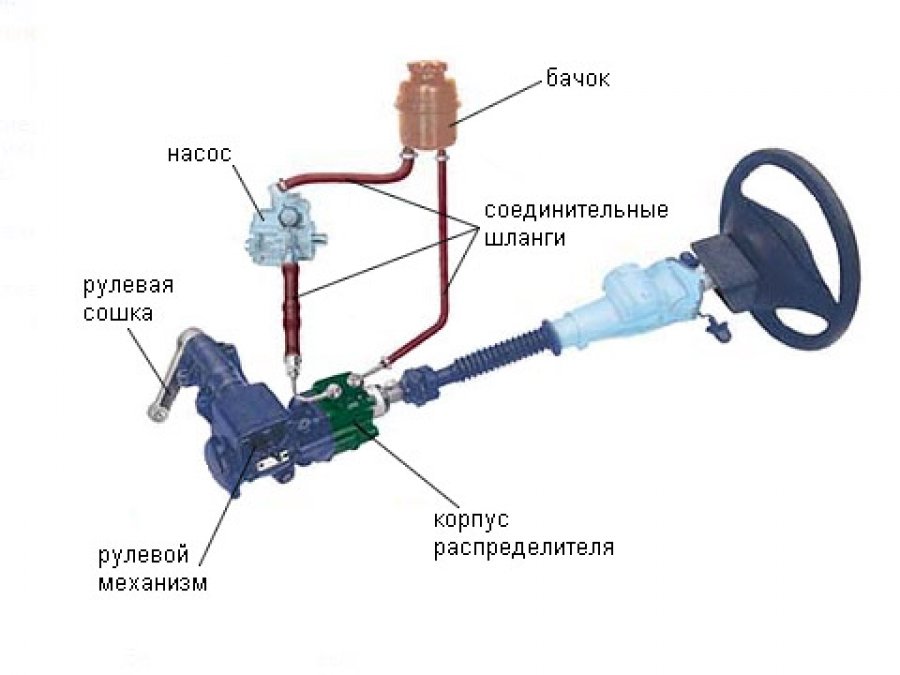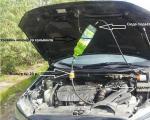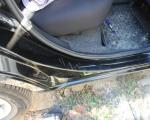What to do if the power steering is buzzing
The power steering is designed to create acceptable driving conditions by easing the effort on the steering wheel. Initially, these mechanisms were installed exclusively on trucks and agricultural machinery. The amplifier was not an element of comfort, its installation was a necessity, since without this node it is simply impossible to turn the steering wheel of a truck or other large equipment. takes on almost all the load that occurs when controlling the rotation of the wheels. The diameter of the steering wheel directly affects the responsiveness of the mechanism. If the car is equipped with a smaller element, turning the wheels from lock to lock will require less speed. In this article we will talk about what to do if the power steering is buzzing. Before proceeding to troubleshoot the problem, let's consider in more detail its design and principle of operation.
Power steering device
There are many different modifications of the hydraulic booster. Thanks to this, its installation can be made on almost any steering mechanism. The most common wheel control system for cars manufactured in 1980-2000 is a rack and pinion mechanism. Most modern models are equipped with electric power steering. The design of the rack amplifier includes the following main elements:
Steering gear , meaning the main control unit without an amplifier.
R dispenser sets the direction of oil flow into a special cavity of the hydraulic cylinder and returns it back. Distributors can be axial or rotary. The first performs translational movements, the second - rotational.
Pump creates the necessary pressure inside the system for the circulation of the working medium.
Tank - a container for the working fluid that circulates in the system. It has a special filter for cleaning the working environment and a dipstick for checking the oil level.
Various connecting elements, tubes and adapters.
In the design of the electric hydraulic booster, in addition to the elements described above, there is an electric control unit and a solenoid valve. The oil pump, which creates the necessary pressure in the system, is in most cases mounted on the engine block. Its drive to work is realized by means of a conventional belt drive. The distributor and the power cylinder are presented as a single integral element in the steering rack.
The principle of operation of the power steering

The pump starts working after the engine is turned on and maintains the set fluid pressure in the booster system. Turning the steering wheel instantly affects the tracking device, the functions of which, as a rule, are performed by the torsion bar. It gives an actuating signal to the distributor mechanism, which then actuates the oil system pressure valve and one of the two valves of the power cylinder cavities. Each of them turns on when turned in its direction. The locking element creates pressure inside the system, thereby taking on the main load. In the absence of steering wheel rotation, the medium simply circulates in the system through the check valves.
If the steering wheel is turned all the way, the system creates maximum pressure on the piston of the power cylinder. To prevent breakage or rupture of hydraulic breaks, a safety valve is provided in the distributor. When the pumped-in oil has nowhere to go, the bypass opens and allows the oil to circulate freely through the system. As a rule, the activation of the safety valve is accompanied by a characteristic sound. Fluid is supplied all the time. For the integrity and long life of the system, it is not recommended to delay the steering turn for more than 10 seconds.
In the electronic power steering, the function of monitoring, supplying and adjusting the working fluid is performed by a solenoid valve, which is controlled by the ECU. The electronic amplifier reads data from a variety of devices, including sensors for speed, crankshaft rotation, steering angle, and so on. Based on the collected information, the control unit changes the level of pressure supplied to the cavity of the power cylinder, smoothly closes and opens the valves. At low speeds, EGUR does not interfere with the circulation of the working flow through the system. When picking up speed, it begins to gradually close the valves, that is, to reduce the pressure of the working environment, thanks to which the steering wheel becomes more informative.
Video from "Main Road" - Power Steering
What to do if you hear the hum of the power steering
The lack of regular technical inspection and timely replacement of consumables causes a lot of unpleasant consequences during the operation of the car. Next, we will consider the main malfunctions when the power steering is buzzing and how to fix them.
The causes of hum or noise in the power steering can be:
Critical working environment . If the oil begins to foam, this means that air has entered the suction line. To remove it, you need to bleed the system. To do this, we start the car and turn the steering wheel from one extreme position to another several times. Do not hold the steering wheel in the extreme position for more than 5 seconds. Sometimes the problem may lie in the quality of the fluid. To replace, you need to pump out the existing fluid using a syringe with a thin tube and fill in a new one. If bubbles are noticed, let the liquid settle, and then turn the steering wheel.
Power steering rack failure . Bearing wear can also cause the symptoms described above. To fix this problem, you need to completely replace the damaged elements. It will be extremely difficult to visually determine the bearing defect, it is better to remove the belt and check each one by touch.
Pump malfunctions , as a rule, happen due to the wear of individual elements of the device. The failure of the working surface of the pump blades cannot be corrected; this entire segment of the system will have to be replaced.
Worn or loose drive belt hydraulic power steering system. Check the belt, if its condition is satisfactory and there are no visible defects, it may need to be slightly tightened.




